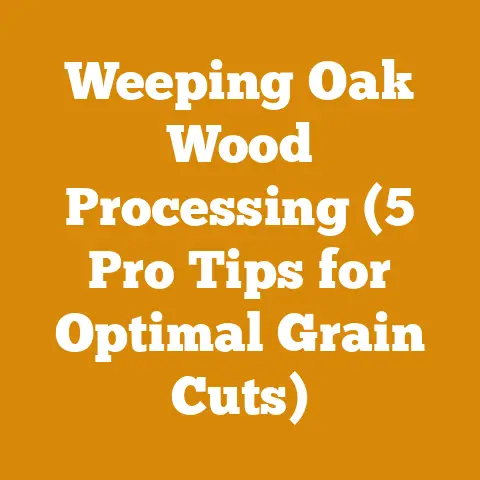Chestnut vs Buckeye Wood: Differences (5 Key Traits)
I remember one frosty autumn morning, a pile of tangled, muddy logs sat in my yard, a mix of chestnut and buckeye, indistinguishable to the untrained eye. By the end of the week, those logs were neatly stacked rows of firewood, ready to warm homes throughout the winter. This transformation wasn’t magic; it was the result of understanding the unique properties of each wood and applying the right techniques. In this guide, I’ll share everything I’ve learned about distinguishing chestnut from buckeye, focusing on five key traits that will help you make the most of these valuable resources.
Chestnut vs. Buckeye Wood: Unveiling the 5 Key Differences
Chestnut and buckeye woods, while both hardwoods, possess distinct characteristics that impact their suitability for various uses, from woodworking to firewood. I’ve spent years working with both, and knowing their differences can save you time, effort, and ensure the best results for your projects.
1. Grain Pattern and Texture: A Visual Guide
The grain pattern is often the first clue in identifying wood. Chestnut boasts a coarse, open grain with prominent pores. This makes it ideal for staining, as the stain penetrates deeply, enhancing the natural beauty of the wood. I’ve used chestnut for rustic furniture where I wanted to emphasize the grain’s texture.
Buckeye, on the other hand, has a much finer, closed grain. The pores are significantly smaller, resulting in a smoother surface. This makes it a great choice for carving and projects where a pristine finish is desired. I once carved a set of chess pieces from buckeye, and the fine grain allowed for intricate detailing.
- Chestnut: Coarse, open grain, prominent pores. Ideal for staining.
- Buckeye: Fine, closed grain, small pores. Ideal for carving and fine finishes.
Takeaway: Examine the grain closely. Chestnut’s open grain is easily visible, while buckeye’s is much tighter and smoother.
2. Color Variations: A Palette of Browns and Creams
Color is another important distinguishing factor. Chestnut typically exhibits a rich, warm brown hue, often with reddish undertones. The heartwood (the wood from the center of the tree) is usually darker than the sapwood (the outer layers). I’ve noticed that older chestnut trees tend to have a deeper, more pronounced color.
Buckeye is generally lighter in color, ranging from creamy white to pale yellow. It lacks the reddish tones found in chestnut. The color is also more consistent throughout the wood, with less distinction between heartwood and sapwood. I’ve often used buckeye in projects where I wanted a light, neutral base for painting or other finishes.
- Chestnut: Warm brown with reddish undertones. Heartwood darker than sapwood.
- Buckeye: Creamy white to pale yellow. Consistent color throughout.
Takeaway: Compare the colors side-by-side. Chestnut’s warm, reddish brown is easily distinguishable from buckeye’s light, creamy tone.
3. Hardness and Density: Measuring Strength and Workability
Hardness and density are crucial factors when considering wood for structural applications or projects that require durability. The Janka hardness test measures the force required to embed a steel ball into the wood.
Chestnut has a Janka hardness rating of around 540 lbf (2,400 N). While not as hard as oak or maple, it’s still a decent hardwood that offers good strength and stability. I’ve used chestnut for flooring in the past, and it’s held up well to moderate foot traffic.
Buckeye is significantly softer, with a Janka hardness rating of only 350 lbf (1,560 N). This makes it one of the softest hardwoods. While not suitable for heavy-duty applications, its softness makes it incredibly easy to work with. I often use buckeye for crafting projects that require intricate cuts and shapes.
- Chestnut: Janka hardness of 540 lbf (2,400 N). Good strength and stability.
- Buckeye: Janka hardness of 350 lbf (1,560 N). Soft and easy to work with.
Takeaway: Consider the intended use. Chestnut is better for projects requiring moderate strength, while buckeye excels in applications where ease of carving and shaping are paramount.
4. Weight and Buoyancy: Assessing Moisture Content and Drying
Weight is closely related to density and moisture content. Denser woods are generally heavier, and woods with high moisture content will also weigh more. I always check the weight of logs before processing them, as it gives me an idea of their moisture content and how long they’ll need to dry.
Chestnut is moderately heavy, weighing around 30 pounds per cubic foot when dry. This weight reflects its decent density and structural integrity. I’ve found that chestnut dries relatively quickly compared to denser hardwoods like oak.
Buckeye is significantly lighter, weighing around 23 pounds per cubic foot when dry. Its low density contributes to its light weight. Buckeye also dries very quickly, which can be both an advantage and a disadvantage. It’s less prone to cracking during drying, but it can also warp if not dried properly.
- Chestnut: Approximately 30 pounds per cubic foot (dry). Moderately heavy.
- Buckeye: Approximately 23 pounds per cubic foot (dry). Very light.
Takeaway: Lift the wood. Buckeye will feel noticeably lighter than chestnut. This difference in weight is a good indicator of their respective densities.
5. Rot Resistance and Durability: Long-Term Performance
Rot resistance is a critical factor, especially when using wood outdoors or in damp environments. Some woods naturally resist decay better than others. I’ve learned this the hard way after using less durable woods for outdoor projects only to see them rot away within a few years.
Chestnut has moderate rot resistance. While not as durable as cedar or redwood, it’s still more resistant to decay than many other hardwoods. I’ve seen chestnut fences and siding that have lasted for decades with proper maintenance.
Buckeye has poor rot resistance. It’s highly susceptible to decay and should not be used in exposed outdoor applications. I’ve only used buckeye for indoor projects where it’s protected from moisture and the elements.
- Chestnut: Moderate rot resistance. Suitable for some outdoor applications with proper maintenance.
- Buckeye: Poor rot resistance. Best suited for indoor use.
Takeaway: Consider the environment. If the wood will be exposed to moisture, chestnut is a better choice. Buckeye should be reserved for indoor projects.
Diving Deeper: Practical Applications and Case Studies
Now that we’ve covered the five key differences, let’s explore some practical applications and case studies that highlight the unique properties of chestnut and buckeye.
Chestnut: The Versatile Hardwood
Chestnut’s combination of moderate hardness, decent rot resistance, and attractive grain makes it a versatile choice for a wide range of applications.
- Furniture: I’ve built several pieces of furniture from chestnut, including tables, chairs, and cabinets. Its strength and stability make it suitable for structural components, while its attractive grain enhances the aesthetic appeal.
- Flooring: Chestnut flooring offers a warm, inviting look and can withstand moderate foot traffic. I’ve installed chestnut flooring in several homes, and the homeowners have been pleased with its durability and appearance.
- Fencing and Siding: With proper treatment and maintenance, chestnut can be used for fencing and siding. Its moderate rot resistance helps it withstand the elements. I’ve seen chestnut fences that have lasted for decades with regular sealing and painting.
- Firewood: Chestnut makes decent firewood, providing a good amount of heat and burning relatively cleanly. I often mix chestnut with other hardwoods to create a well-rounded firewood supply.
Case Study: Restoring a Historic Barn
I was involved in a project to restore a historic barn that was originally built with chestnut timbers. The timbers had been exposed to the elements for over a century, but many were still in surprisingly good condition. We were able to salvage a significant amount of the original chestnut and use it to rebuild the barn’s frame. This project demonstrated the long-term durability of chestnut when properly maintained.
Buckeye: The Carver’s Delight
Buckeye’s softness, fine grain, and light color make it an ideal choice for carving and other delicate woodworking projects.
- Carving: Buckeye is a favorite among carvers due to its ease of workability and ability to hold fine details. I’ve seen incredible sculptures and carvings made from buckeye, showcasing its versatility as a carving medium.
- Small Crafts: Buckeye is well-suited for small crafts, such as boxes, bowls, and decorative items. Its light color and smooth surface make it easy to paint and finish.
- Soundboards: Buckeye is sometimes used for soundboards in musical instruments, such as guitars and violins. Its low density and resonant properties contribute to the instrument’s sound quality.
- Pulpwood: Buckeye is also used in the production of pulpwood for paper manufacturing. Its soft fibers make it easy to process into paper pulp.
Case Study: Creating Intricate Wood Carvings
A local artist I know specializes in creating intricate wood carvings from buckeye. He uses a variety of hand tools and power tools to shape the wood into stunning sculptures. He prefers buckeye because its softness allows him to create fine details without the wood splitting or chipping. His carvings are highly sought after by collectors and galleries.
Mastering the Tools: Essential Equipment for Working with Chestnut and Buckeye
Working with chestnut and buckeye requires a range of tools, from basic hand tools to more specialized power equipment. Here’s a breakdown of the essential tools I use:
Chainsaws: Felling and Bucking
A chainsaw is essential for felling trees and bucking logs into manageable lengths. I recommend using a chainsaw with a bar length appropriate for the size of the trees you’re working with.
- Chainsaw Selection: Choose a chainsaw with a sufficient engine size for the diameter of the logs. For smaller trees (under 12 inches), a 40cc chainsaw may suffice. For larger trees, a 50cc or larger chainsaw is recommended.
- Safety Gear: Always wear appropriate safety gear when operating a chainsaw, including a helmet, eye protection, hearing protection, gloves, and chaps.
- Maintenance: Regularly sharpen the chain and maintain the chainsaw according to the manufacturer’s instructions.
Log Splitters: Efficient Firewood Processing
A log splitter can significantly speed up the process of splitting firewood. I prefer using a hydraulic log splitter, which provides plenty of power for splitting even the toughest logs.
- Log Splitter Selection: Choose a log splitter with a sufficient tonnage rating for the size of the logs you’ll be splitting. A 20-ton log splitter is generally sufficient for most firewood processing needs.
- Safety Precautions: Always wear safety glasses and gloves when operating a log splitter. Keep your hands clear of the splitting wedge.
- Maintenance: Regularly check the hydraulic fluid level and lubricate the moving parts of the log splitter.
Hand Tools: Carving and Shaping
For carving and shaping buckeye, a variety of hand tools are essential.
- Carving Knives: A set of carving knives with different blade shapes is essential for detailed carving work.
- Chisels: Chisels are used for removing larger amounts of wood and creating clean, precise cuts.
- Gouges: Gouges are curved chisels used for creating rounded shapes and contours.
- Rasps and Files: Rasps and files are used for shaping and smoothing wood surfaces.
Power Tools: Speed and Precision
Power tools can speed up the carving and shaping process and provide greater precision.
- Rotary Tools: Rotary tools, such as Dremels, are versatile tools that can be used for carving, sanding, and polishing.
- Power Carvers: Power carvers are specialized tools designed for carving wood. They use a reciprocating blade to quickly remove wood.
- Sanders: Sanders are used for smoothing wood surfaces and preparing them for finishing.
Drying Techniques: Achieving Optimal Moisture Content
Proper drying is crucial for preventing warping, cracking, and decay in both chestnut and buckeye. The goal is to reduce the moisture content to a level that is stable for the intended use.
Air Drying: A Natural Approach
Air drying is a traditional method that involves stacking the wood in a well-ventilated area and allowing it to dry naturally over time.
- Stacking: Stack the wood with stickers (thin strips of wood) between each layer to allow for air circulation.
- Location: Choose a location that is sheltered from rain and direct sunlight.
- Time: Air drying can take several months or even years, depending on the thickness of the wood and the climate.
Kiln Drying: Speeding Up the Process
Kiln drying involves using a controlled environment to accelerate the drying process.
- Kiln Design: Kilns use heat and humidity to control the rate of drying and prevent warping and cracking.
- Temperature and Humidity: The temperature and humidity are carefully monitored and adjusted throughout the drying process.
- Time: Kiln drying can reduce the drying time from months to weeks.
Measuring Moisture Content
A moisture meter is essential for determining the moisture content of the wood.
- Pin Meters: Pin meters use two pins that are inserted into the wood to measure the electrical resistance, which is correlated to moisture content.
- Pinless Meters: Pinless meters use radio frequency signals to measure moisture content without damaging the wood.
- Target Moisture Content: The target moisture content will vary depending on the intended use. For indoor furniture, a moisture content of 6-8% is ideal. For firewood, a moisture content of 20% or less is desired.
Finishing Touches: Enhancing Beauty and Protection
Applying a finish can enhance the beauty of the wood and protect it from moisture, scratches, and other damage.
Sanding: Preparing the Surface
Sanding is essential for creating a smooth, even surface for finishing.
- Grit Selection: Start with a coarse grit sandpaper (e.g., 80 grit) to remove any imperfections. Gradually increase the grit to finer grits (e.g., 120, 180, 220) to create a smooth surface.
- Sanding Techniques: Sand with the grain of the wood to avoid scratching.
- Dust Removal: Thoroughly remove all dust after sanding.
Staining: Adding Color and Depth
Staining can add color and depth to the wood, enhancing its natural grain.
- Stain Selection: Choose a stain that complements the wood’s natural color.
- Application: Apply the stain evenly with a brush or cloth.
- Wiping: Wipe off any excess stain after a few minutes.
Sealing: Protecting the Wood
Sealing protects the wood from moisture and other damage.
- Sealer Selection: Choose a sealer that is compatible with the stain and topcoat.
- Application: Apply the sealer evenly with a brush or cloth.
- Sanding: Lightly sand the sealer after it dries to create a smooth surface for the topcoat.
Topcoating: Adding Durability and Shine
Topcoating adds durability and shine to the finish.
- Topcoat Selection: Choose a topcoat that is appropriate for the intended use. Polyurethane is a durable topcoat that is suitable for furniture and flooring. Lacquer is a fast-drying topcoat that is often used for fine furniture.
- Application: Apply the topcoat evenly with a brush, spray gun, or cloth.
- Sanding: Lightly sand the topcoat between coats to create a smooth finish.
Safety First: Protecting Yourself and Others
Safety is paramount when working with wood processing tools and equipment. Always follow these safety guidelines:
- Wear Appropriate Safety Gear: Always wear safety glasses, hearing protection, gloves, and other appropriate safety gear.
- Read and Understand Instructions: Read and understand the manufacturer’s instructions for all tools and equipment before using them.
- Maintain Tools and Equipment: Regularly maintain your tools and equipment to ensure they are in good working order.
- Work in a Well-Ventilated Area: Work in a well-ventilated area to avoid inhaling dust and fumes.
- Avoid Distractions: Avoid distractions when operating tools and equipment.
- Never Work Alone: Never work alone in a remote area.
- Know Your Limits: Know your limits and don’t attempt tasks that are beyond your skill level.
Addressing Common Challenges: Troubleshooting Tips
Even with the best planning and preparation, challenges can arise when working with chestnut and buckeye. Here are some common challenges and troubleshooting tips:
- Warping: Warping can occur if the wood is not dried properly. To prevent warping, ensure that the wood is stacked properly and dried slowly.
- Cracking: Cracking can occur if the wood dries too quickly. To prevent cracking, control the drying rate and avoid exposing the wood to direct sunlight.
- Splitting: Splitting can occur when splitting firewood. To prevent splitting, use a sharp axe or log splitter and split the wood along the grain.
- Tear-out: Tear-out can occur when machining wood with a planer or jointer. To prevent tear-out, use sharp blades and feed the wood slowly.
- Uneven Staining: Uneven staining can occur if the wood is not properly prepared. To prevent uneven staining, sand the wood thoroughly and apply a sealer before staining.
Conclusion: Embracing the Unique Qualities of Chestnut and Buckeye
Chestnut and buckeye are two distinct hardwoods that offer unique qualities for a variety of applications. By understanding their differences in grain pattern, color, hardness, weight, and rot resistance, you can choose the right wood for your projects and achieve the best results. Remember to prioritize safety, use the right tools, and follow proper drying and finishing techniques. With a little knowledge and practice, you can unlock the full potential of these valuable resources and create beautiful, durable, and long-lasting projects.






